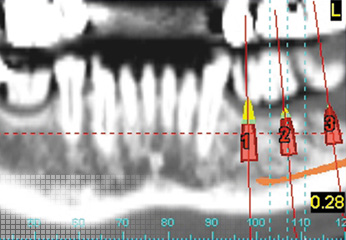


Bone Transplantation
Bone Transplantation
Bone augmentation - for the long-term stability of your implants
We employ various methods for a successful bone augmentation from which we select the most suitable one(s) depending on the condition of the bone tissue in each individual case. Basically we can offer our patients all currently available bone augmentation methods. For small bone defects or as a complementary measure in the case of a bone transplantation the use of bone replacement material is highly recommendable. However, the exclusive use of bone replacement material (a tempting choice, since it is widely available) is only a second-rate solution. Far better results can be achieved with a mixture of the 'dead' bone replacement material and the 'living' bone tissue, such as bone grafts, gathered from the patient's jaw bone while drilling. Experts all over the globe regard the patient's own bone tissue as the best material for regeneration - especially after a substantial loss of bone. Our team at Miramed usually gathers the bone tissue needed for transplantation from the jaw area (e.g. angle of the jaw) without causing the patient too much pain.
Bone augmentation - a gentle and safe procedure
Thanks to our sophisticated methods our team is able to treat even extreme cases of extensive bone loss without resorting to bone extraction from other parts of the body. Our treatment methods cause very few post-operative discomforts and facilitate extremely shorts periods of recuperation. Even in complicated cases the operation can be carried out on an out-patient basis and under local anaesthesia. If required, or in the case of medical necessity, bone augmentation and the anchoring of implants can also be performed under general anaesthesia.
After a healing period of several months, the transplanted bone has usually stabilised to such a degree that the implants can be anchored. At MiraMed bone augmentation and implantation are often performed in a single session. This tried-and-tested technique means that we can substantially reduce the number of treatment dates, but also greatly reduce the costs by achieving two steps in one session. The objective - implant-based dental prostheses - can thus be attained in half the time.



